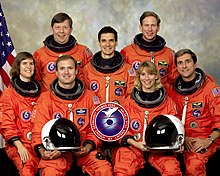STS-94

Launch of Space Shuttle Columbia on STS-94
|
|||||
| Mission type | Microgravity research | ||||
|---|---|---|---|---|---|
| Operator | NASA | ||||
| COSPAR ID | 1997-032A | ||||
| SATCAT № | 24849 | ||||
| Mission duration | 15 days, 16 hours, 45 minutes, 29 seconds | ||||
| Distance travelled | 10,000,000 kilometres (6,200,000 mi) | ||||
| Spacecraft properties | |||||
| Spacecraft | Space Shuttle Columbia | ||||
| Landing mass | 117,802 kilograms (259,709 lb) | ||||
| Payload mass | 10,169 kilograms (22,419 lb) | ||||
| Crew | |||||
| Crew size | 7 | ||||
| Members |
James D. Halsell Susan L. Still Janice E. Voss Michael L. Gernhardt Donald A. Thomas Roger Crouch Greg Linteris |
||||
| Start of mission | |||||
| Launch date | 1 July 1997, 18:02:02 UTC | ||||
| Launch site | Kennedy LC-39A | ||||
| End of mission | |||||
| Landing date | 17 July 1997, 10:47:29 UTC | ||||
| Landing site | Kennedy SLF Runway 33 | ||||
| Orbital parameters | |||||
| Reference system | Geocentric | ||||
| Regime | Low Earth | ||||
| Perigee | 296 kilometres (184 mi) | ||||
| Apogee | 300 kilometres (190 mi) | ||||
| Inclination | 28.45 degrees | ||||
| Period | 90.5 minutes | ||||
|
|
|||||


Left to right - Front row: Voss, Halsell, Still, Thomas; Back row: Crouch, Linteris, Gernhardt
STS-94 was a mission of the United States Space Shuttle Columbia, launched on 1 July 1997.
This was a reflight of the STS-83 Microgravity Science Laboratory (MSL) mission. MSL was originally launched on 4 April 1997 at 2:20 pm EST and was intended to be on orbit for 15 days, 16 hours. The mission was cut short due to a problem with Fuel Cell #2 and Columbia landed on 8 April 1997 after 3 days 23 hours.
The primary payload on STS-83 was the Microgravity Science Laboratory (MSL). MSL was a collection of microgravity experiments housed inside a European Spacelab Long Module (LM). It built on the cooperative and scientific foundation of the International Microgravity Laboratory missions (IML-1 on STS-42 and IML-2 on STS-65), the United States Microgravity Laboratory missions (USML-1 on STS-50 and USML-2 on STS-73), the Japanese Spacelab mission (Spacelab-J on STS-47), the Spacelab Life and Microgravity Science Mission (LMS on STS-78) and the German Spacelab missions (D-1 on STS-61-A and D-2 on STS-55).
MSL featured 19 materials science investigations in 4 major facilities. These facilities were the Large Isothermal Furnace, the EXpedite the PRocessing of Experiments to the Space Station (EXPRESS) Rack, the Electromagnetic Containerless Processing Facility (TEMPUS) and the Coarsening in Solid-Liquid Mixtures (CSLM) facility, the Droplet Combustion Experiment (DCE) and the Combustion Module-1 Facility. Additional technology experiments were to be performed in the Middeck Glovebox (MGBX) developed by the Marshall Space Flight Center (MSFC) and the High-Packed Digital Television (HI-PAC DTV) system was used to provide multi-channel real-time analog science video.
...
Wikipedia
